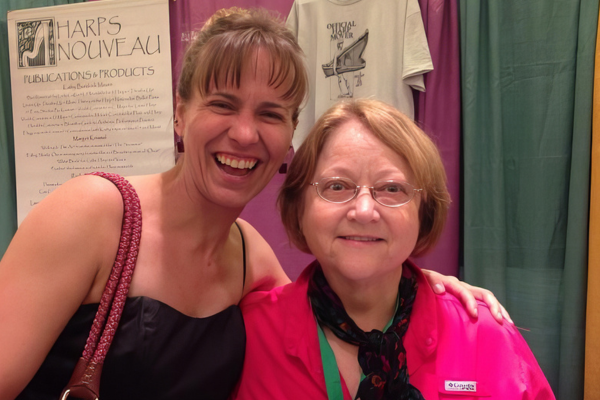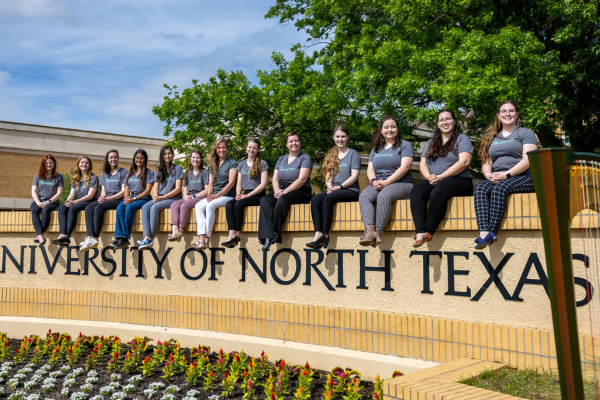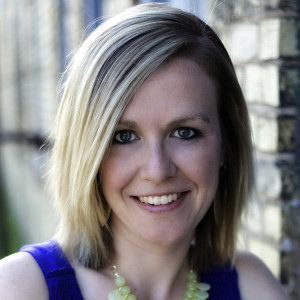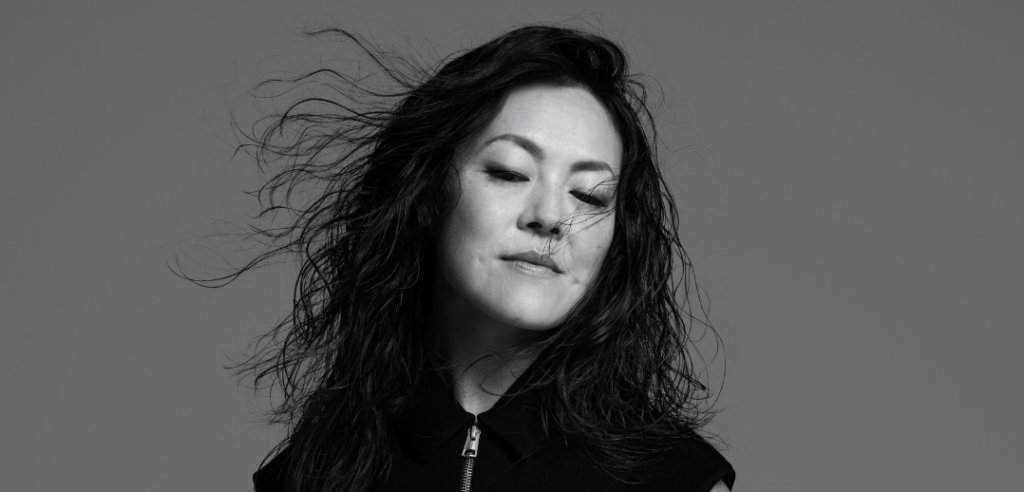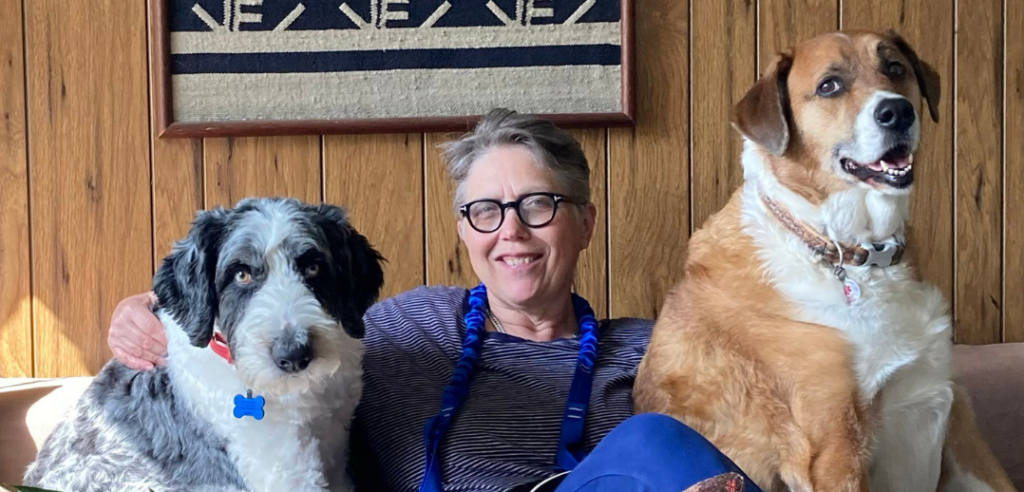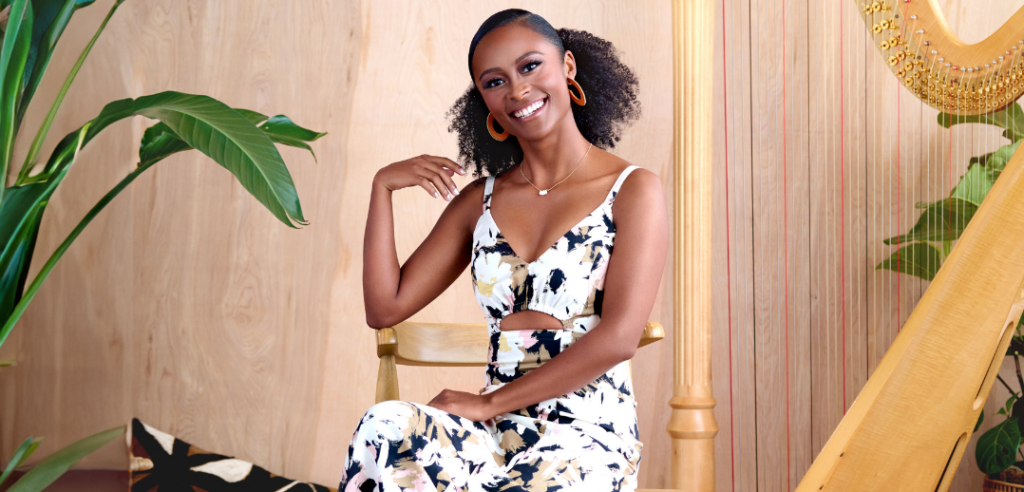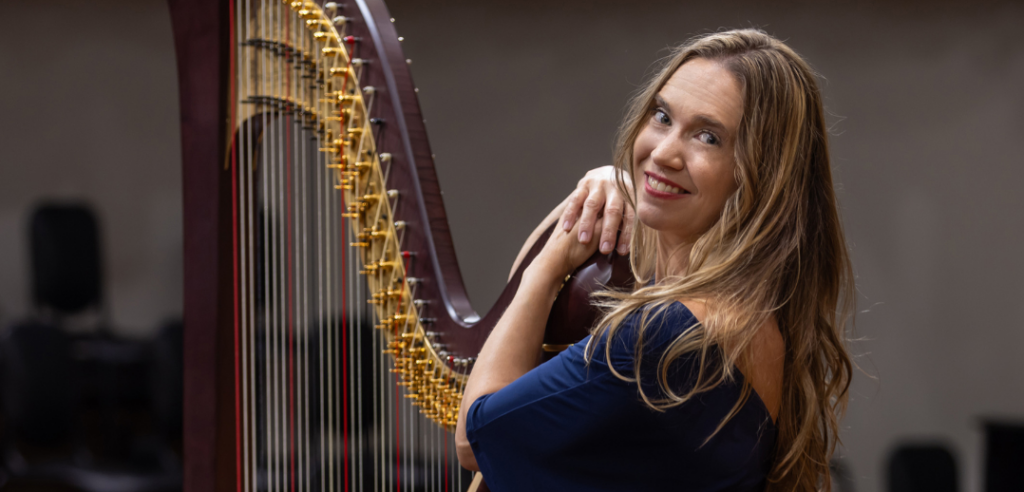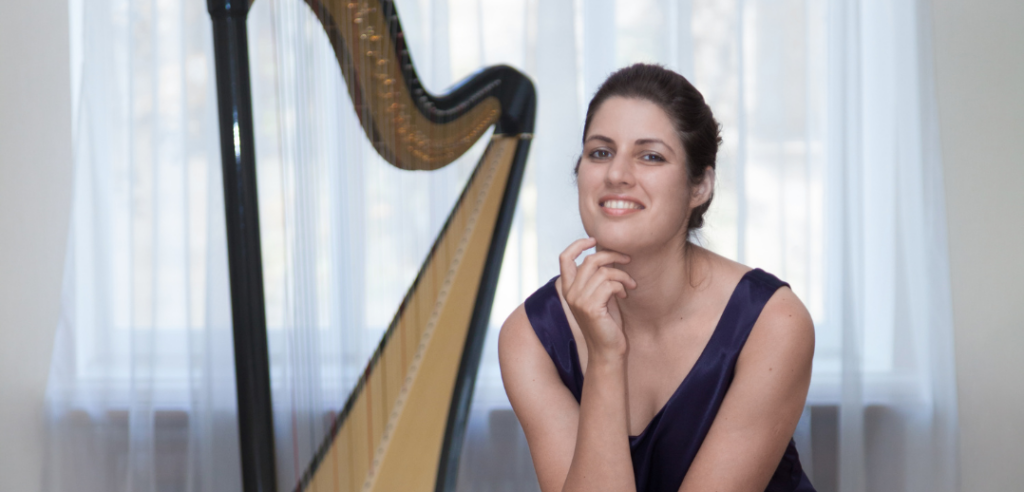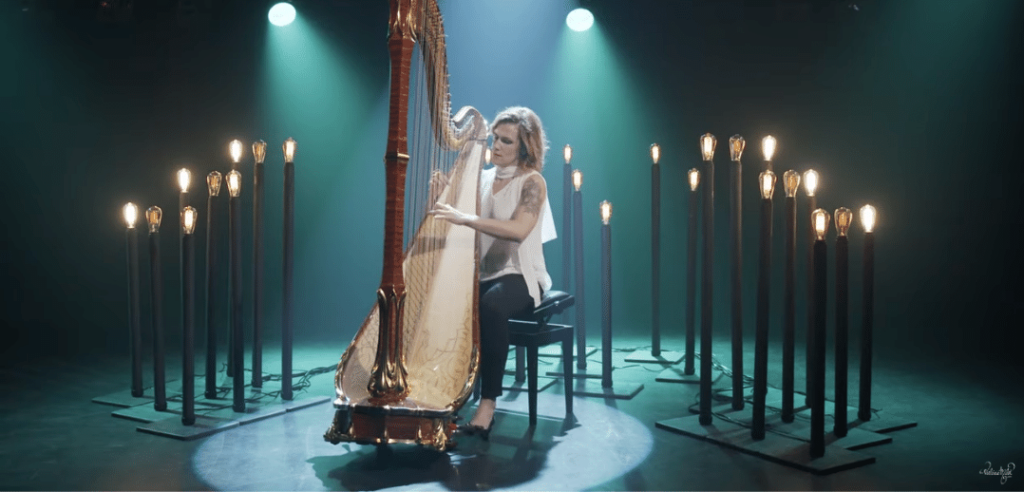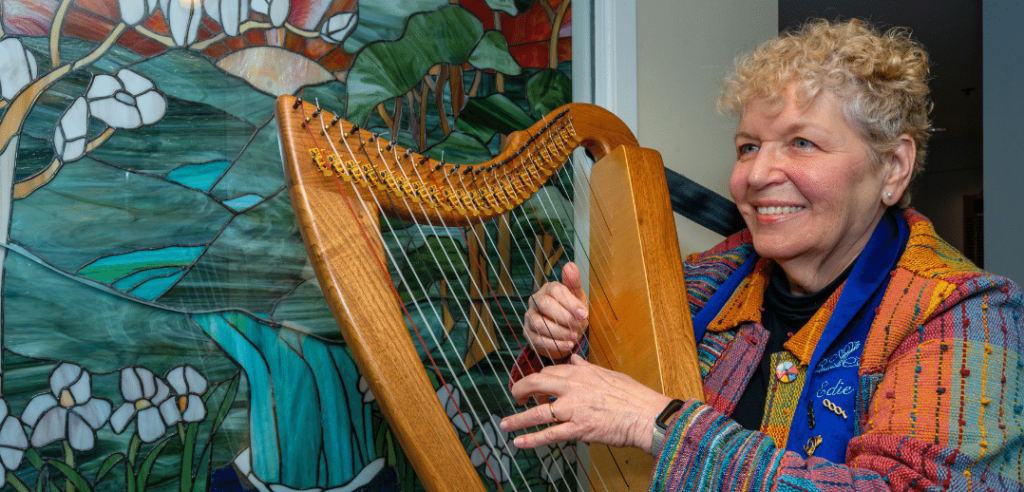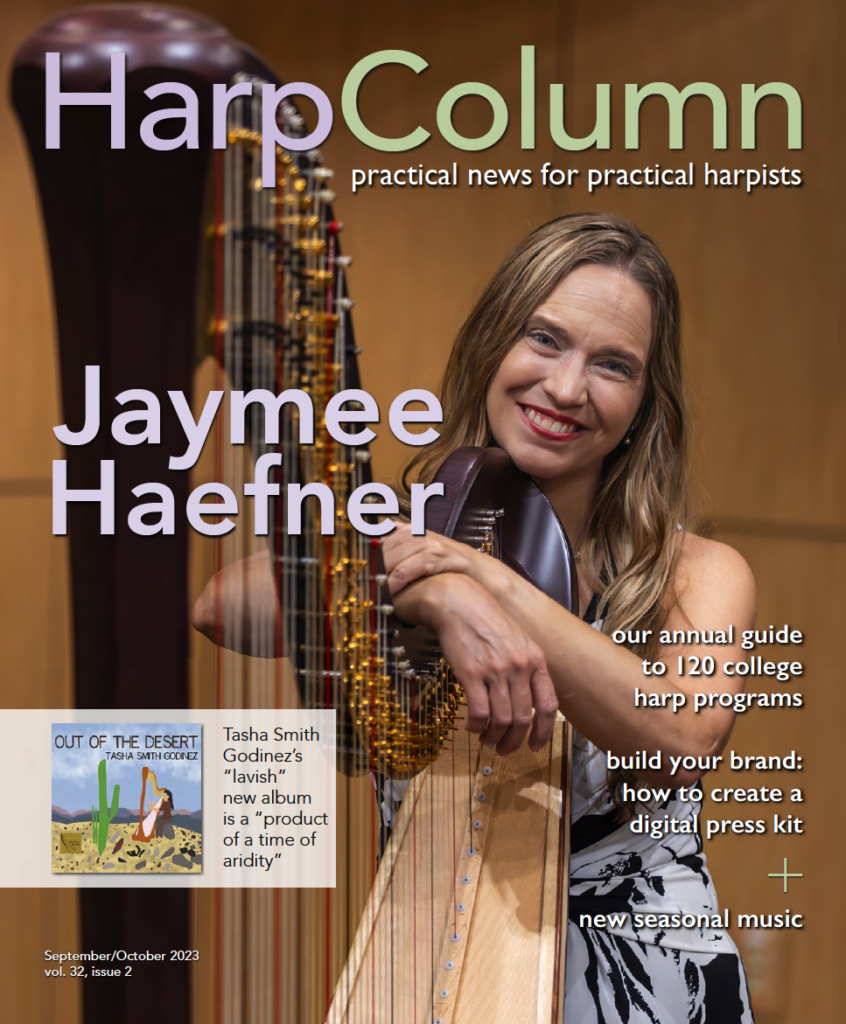Without [context], any preparation for a competition or recital or any other performance is stagnant. It has to have life—whether the composer is alive or not—the music must have life.
The question “Where are you from?” is an interesting one for a musician to consider. Are you from a place? A school? A method of playing? Maybe you consider your roots to be in the music that influenced you or the musicians who paved the way for you. Harpist Jaymee Haefner counts herself lucky as she considers where she is from. The girl from Sioux Falls, South Dakota, traces her harp lineage directly back to the legendary early 20th century harp teacher-performer-composer Henriette Renié. But it was more than her harp teachers that made her the musician she is today. She credits her larger music community, her family, and her students for shaping her musical growth. The harp teacher at the University of North Texas (UNT) for the last 17 years, Haefner is immersed in shaping the musical lives of the students that pass through the school’s robust harp program. We caught up with Haefner in July while she was enjoying some time in the Black Hills of South Dakota where she vacationed as a child.
Harp Column: Your students—both current and former—enjoyed a lot of success at this summer’s [American Harp Society] National Competition. Recent UNT alum Kaitlin Miller was named AHS Concert Artist, winning the top prize in the Young Professional Division. Margaret Gunter finished first in the Advanced Division, and Kathryn Horton took fifth prize in the Intermediate II Division. Tell us about your philosophy regarding students in music competitions.
Jaymee Haefner: Absolutely. The first and probably most important piece is that students, if they choose to enter a competition, need to be doing it for personal growth. They shouldn’t do it to receive accolades from others; they shouldn’t compete to receive fame. It really has to be an individual choice, and it’s never a requirement that I make of my students. If [a student] wants to compete, I am very happy to support them in doing that. But most importantly, competition is an individual path. It’s not competing against others—it’s competing against yourself. In my personal journey, every time I entered a competition, I found there were these external factors that caused me to grow. But the decision to enter a competition had to start with loving the music. If I had a personal connection with the music, I found that I always did better in competitions. That’s certainly been true of my students as well. This particular year, the repertoire [in the American Harp Society National Competition] was just so extraordinary, as was the opportunity for the students to meet and interact with composers like Caroline Lizotte. It was a perfect real-world scenario for them to collaborate with somebody who’s not only a brilliant and amazing harpist in her own right, but also so excited about elevating others. That’s what a competition philosophy should be about. It should never be about putting your thumb down on other people’s shoulders, but elevating everybody, so everybody can grow through the experience. I would also say that having been on the other side [of competitions], as a jury member, I experienced growth this way as well. It’s an interactive experience in a way the competitors don’t always realize.
HC: That’s an interesting perspective. How do you go about preparing a student for a national or international competition?
JH: The first thing I would say is that it’s not a top-down process, it really works best when there are several students who are preparing for competitions together. As a teacher, I’m setting the stage, getting the students excited about the background of the pieces. If you’re learning a piece by Renié, find out what was happening in her life at that time. Was it between the two World Wars when she wrote this, or was she 20 years old, just starting to experience life? That has to be infused into the performance. Without [context], any preparation for a competition or recital or any other performance is stagnant. It has to have life—whether that composer is alive or not—the music must have life. I also think it’s important to start early, but keep it fresh at the same time. Those two things can be in competition with one another—competing for freshness and not having to restart from the beginning every day. You have to build upon your previous work and make your preparation deeper and more comprehensive. There are several ways I do this with my students. We do theoretical analysis, we do historical analysis, we do plenty of practice performances. But most of all, when it comes time to memorize the piece, they already have to know it forwards and backwards, and then that act of discovery must be circular. It’s like stirring a pot of soup, right? You want to make sure that the older notes don’t get stale and burnt at the bottom and that you’re mixing in the spices so it continually gets better.
HC: That’s a good analogy. Do you ever encounter circumstances in which you don’t think a student should enter a competition?
JH: I do. But it’s always a mutual decision. When it starts to cause so much stress that it impacts their love for the instrument or their love for playing, that’s when I believe somebody should step away and look for a different way to use those pieces. Maybe you put the music on a creative recital or take a completely different direction or put the pieces away for a little while and then come back to them. There’s always a reason [when the timing is not right], whether it’s something that’s happening personally in the student’s life or maybe there’s something that they’re encountering technically in that piece that they haven’t quite mastered. If a student is working so hard on a technique that it can’t be played with ease, then it is not serving what the composer intended. Art is work, as we all know, but it shouldn’t be labor. There’s no way to succeed in your art if it’s labor.
On the other side of the coin, there is a spark that hits me with certain students, and [Kaitlin Miller] was one of them. While she was [my student and] competing, sometimes she’d win and sometimes she didn’t, but it was apparent to me that she would have a big win someday. I remember counseling her, “Your time will come, I guarantee your time will come. It just has to be the right time and the right repertoire.” I couldn’t be happier for her. Margaret [Gunter] and Kathryn [Horton] too—they all have that similar spark. They love to practice, and they can’t get enough. I want to go on the record saying that is something that’s not teachable. I think that’s innate. My job as a teacher is to keep that fire going and to make sure I don’t put it out. That spark is so much more important, I believe, than fingerings or dynamics or whatnot.
HC: Let’s talk about your college teachers. You studied with two massive figures in the American harp world in the last 50 years—Susann McDonald and Carrol McLaughlin. How did your college teachers shape you as a musician and as a teacher?
JH: Well, you’re absolutely right. They’re both such massive figures in the harp world, and, at the same time, very different from each other. I was fortunate in that all of my teachers studied with each other. So if you don’t mind, I’ll take us one step back. My very first teacher, Anna Vorhes, was a student of Carrol McLaughlin. And before Anna Vorhes, I studied with Frances Miller. She wasn’t part of the same [pedagogical] line, but she used to travel around [the Upper Midwest] to teach. She probably started more harp students than anybody that ever lived. When Anna Vorhes moved to [my hometown of] Sioux Falls, South Dakota, I was one of her first students. She talked about her teacher, Carrol McLaughlin, and both Anna and Carrol had a real, holistic approach to teaching that wasn’t just the notes on the page. It was really getting in and around the notes and figuring out how the music could speak. I was transfixed by that, and I wanted to study with Carrol and understand more about it.
It was logical that I would eventually study with her, but there was one other teacher in between—Kathy Bundock Moore. I studied with her for one year, and from her, I learned much more about the mechanics of teaching, specifically the theoretical side. She was a brilliant mastermind and had such a love of teaching and of playing. After that year, I studied with Carrol McLaughlin. She had a real gift of giving students the confidence that would sometimes counteract their previous experiences. I think that’s why so many of her students are successful. She seemed to understand the way our minds work and the way our minds can play games with us when we’re on stage. I learned a lot about that side of teaching and competition preparation from her.
You become the music when you are really well prepared for a competition.
Of course [Carrol McLaughlin] studied with Susann McDonald, so it was logical that I would go to study with Susann for my doctorate. All of this was in a direct line to understanding Henriette Renié better. [Ed.—Susann McDonald was the last major student of early 20th century French harpist Henriette Renié.] It was interesting to study with everyone in this line back to Renié. From Miss McDonald I learned how to prepare for competitions myself. I was one of the concerto competition winners at [Indiana University], and I happened to be eight months pregnant at the time, which is quite a story in itself. [Laughs] But [preparation] was a love of growing, it was a love of competing, it was a love of going so far beyond the notes on the page that the music almost disappears. You become the music when you are really prepared for a competition. I go back to what Miss McDonald always said, “You have to love your playing.” And that comes from Henriette Renié as well. If you do that, the rest of the preparation is easy. It comes out of that immersion in art. I think any detour that goes around that will not be successful. You really have to be the art.
HC: In the 17 years that you have been teaching at the University of North Texas, what kind of harp student would you say finds success at the college level?
JH: It really depends on how you define success. I think success as a college student now is very different from success as a college student 10 years ago, or 10 years before that, or when I was a doctoral student, or when I was an undergraduate student. I believe success comes when you are truly open to new ideas and new experiences and you are willing to try anything, then you can find your focused path. That is what the whole college experience is about, whether you’re at a state school, a traditional conservatory, or somewhere in between. On the flip side of that, if there’s a trend that ever worries me, it would be somebody who comes into the university and says, “Nope, I only want to do solo harp repertoire. Nothing else. I’m not interested in learning about jazz. I’m not interested in learning about the Baroque era. I’m just here to play as much Grandjany, Renié, and Salzedo as I can.” [Universities] were built around these physical store houses of knowledge—libraries—which were designed to be diverse. Now, in the modern university, we acquire so many different types of knowledge through different media—those are the opportunities that you don’t necessarily get in any other place. And that’s really what makes me so excited about teaching and performing in a university setting. It’s the diverse ideas that enrich your thinking and elevate the experience.
HC: At UNT, you have a student harp ensemble called HarpBeats. Was it inspired by the Harp Fusion ensemble at the University of Arizona, or did it already exist before you arrived?
JH: I will give a little history to explain HarpBeats. The University of North Texas harp studio is so much older than most people realize. This was the 80th year since its creation. It’s one of the older harp studios in the United States, and from the very beginning, there were harp ensemble performances. Salzedo actually came with his ensemble and did a major performance in our main auditorium. When I came to UNT, the students and I collectively decided to redefine and modernize the harp ensemble class because it’s so much more than just learning to play together. As harpists, of course, we need lots of practice playing together to prepare for orchestral and band positions out in the real world, but there is also that element of learning how to arrange music. That was one of the things that I certainly learned from Carrol McLaughlin [at Arizona], and it was one of the most valuable skills that I had going into the real world as a professional harpist. I wanted to make sure that my students had that experience in addition to the performing experience. Learning how to use [music] notation software is a skill that every musician has to have, and what better way to learn that then to arrange a piece that you happen to love. So that was really the reason that we started all of this.
HC: For the students reading this issue with our college guide, getting ready for the audition process, what advice would you give them as they prepare?
JH: The first piece of advice always, is to play music that you are comfortable with. I have seen so many students who will prepare a piece that is just at the outskirts of their comfort level and ability, and they’ll come in [to an audition] and play it technically well, but not musically. Those of us sitting on the other side of the table, so to speak, we’re looking at potential. We’re looking at what the student can do, not what they’ve already done, but whether they are open and moldable. It’s irrelevant whether a student is aiming to be a performance major or a theory major that plays harp or a composition major. We would not expect a student to be perfect at that point, but we expect them to be proficient and excited about studying.
HC: You’ve mentioned Henriette Renié several times, and you’ve published a couple of books about her. She is another big figure in the harp world, but several generations removed from us today, having lived during the first half of the 20th century. What about Renié resonates with you, and what do you think harpists today can learn from her music and her work a century ago?
JH: It’s such a good question. The first time I heard about Renié, it was through some of the warmups and exercises that I learned initially with Anna Vorhes. I think the first thing I said was, “Oh, tell me more about him.” And Anna said, “Oh, no, Jaymee, Renié was a she.” This was the first thing that captured me—all of the music I was learning was by men, and all of the harpists I was learning about were men. Renié broke that gender barrier, much like other harpists of [the 20th century] who deserve shout outs like Alice Chalifoux and others who went against the grain. But what Renié did differently was that she was a holistic artist—she was a teacher, she was a performer, she was a composer—and she did all of it at such a high level. And then somehow, she managed to set up the first international harp competition with some of the biggest musicians that could possibly be on a jury—Maurice Ravel, Gabriel Pierné, Paul Paray, Charles-Marie Widor—the biggest names of that time. And then also, somehow she managed to support other artists. She lived during both World Wars, and artists were struggling a lot during that time, much like we all have during COVID. During the World Wars, concerts were canceled and big gatherings ceased to exist. [Renié] would go out and give performances in a black gown, wearing a big cross (she was very devout), and she would raise funds for other artists who were struggling. And so when you ask what resonates with me, I see so many parallels between her life and our lives right now. While our world is very different from what she experienced, we have lived through something that was very traumatic. While it might not repeat, certainly history rhymes with itself, and it continues to invigorate my research into her life. Every time that I go back to her method, or every time I go back to Miss McDonald’s markings in my music, I am truly struck by how timeless those are. While she played on a very different sort of harp than our concert grands, it all translates, and it just shows how timeless her art is.
HC: You grew up in Sioux Falls, South Dakota, which is not exactly known as a hotbed of classical music. How did you get started playing the harp?
JH: You’re right. Especially when I was growing up, there was not much of an art scene in Sioux Falls, and we were quite a ways away from Midwest cities like Minneapolis-St. Paul or Omaha or any of these metropolitan communities where art naturally grows. I was very fortunate that Anna [Vorhes] moved to Sioux Falls, because she really started the harp community there. In the past 40 years or so, it has risen to a completely different level. But back then, the best way to get a well-rounded musical education was actually to seek non-harp opportunities and then hope harp would be added to them. For instance, my high school didn’t have an orchestra, but we had a wonderful band and a wonderful choir. So I started playing french horn and I sang in the choir. Then sometimes we would get to do a piece with harp. As a performer, I learned so much about phrasing and breath control, both from playing the horn and from singing. From my piano teacher, I learned so much about the great literature that wasn’t originally written for the harp. Looking back, it would be easy to say, “Too bad I didn’t get to do as many harp things.” But I would actually say, I was the luckiest one of all, because through piano, harp, horn, and voice, I managed to have a multifaceted experience, which is precisely what I hope to provide for my students. And while some might look at that and say, “Oh, well, you’re doing a little of all these different things.” It’s really the nucleus at the middle of that where the creation comes from. It’s not from whether we play vertical strings, or horizontal keys, or whether we blow through a long metal tube. It’s really that cross pinning of understanding—that’s where the creativity happens. I’m lucky in that regard, and also to have had teachers that supported each other, and parents that supported me. Without their support, I never would have been able to piece this puzzle together. So the community for me was much wider than a harp community.
HC: What role does community play in learning to be a musician?
JH: The role of community, I believe, is really to keep us from becoming too full of ourselves. To keep us from the mindset of “it’s only my way” that something can be done. Community continually challenges that. It goes back to why the university setting is so crucial. I am continually proven wrong, not because I don’t know what I’m doing, but because, by definition, learning is growth. When you are stuck in one mindset, your learning is stagnant, it dies. The community always forces you to go further outside of yourself to find solutions. •
Learning more about the teacher

What is on the top of your music stand right now?
A piece called …snow haze, moonlight by Libby Larsen.
What is your favorite piece to play as an encore?
I love the Glière Impromptu. It’s short and sweet, and everybody loves it.
Which is worse: Texas in the summer or South Dakota in the winter?
That’s a really close one. I’d say South Dakota in the winter, at least for moving the harp.
What’s your favorite vacation spot?
It’s constantly changing—usually wherever I just most recently went. I’d have to say Peru. I was fortunate to go there, and it was unlike anything I’d ever seen.
What kind of harpmobile do you drive?
I have a [Toyota] 4Runner, and her name is Sapphire.
If you were not a harpist, what would you do for a living?
I would probably be a master scuba diver. I just got my advanced diving certification, and I love it. I think I would guide scuba diving trips. But if you had asked me five years ago, it would have been totally different. Right as I was starting to teach pedagogy this year, I challenged all of my students to learn something completely, totally different and new, because it teaches us humility. I was horrible at first—I couldn’t even go under the water without hyperventilating. Now, I’ve been past 100 feet, so it’s all good.
What is your favorite road trip snack?
The Hot Tamales candy! It’s the only time I eat them—they keep me awake. And kombucha to drink. I guess I balance the healthy with the unhealthy.
If you had a motto, what would it be?
Be kind.
What is your preferred footwear at the harp?
I wear very specifically Beautifeel (brand) Tara (model). They’ve stopped making them, so the only place I can buy them is used on eBay. So if you see them listed, please tell me!
What is your favorite movie?
A River Runs Through It, partially because of the fly fishing element—my father always fly fished.
Are you a dog person or a cat lover?
I’m a dog person, for sure. I have two dogs—Roscoe and Coltrane.








